Analysis of Starbucks' Change Management Strategy: A Level 7 Report
VerifiedAdded on 2022/11/13
|8
|1518
|246
Report
AI Summary
This report critically analyzes Starbucks' ineffective change management strategy when introducing tea to its menu. It examines the absence of effective market research and the failure to utilize change management models, such as Lewin's or Kotter's, which led to the initiative's underperformance. The report highlights the crucial relationship between leadership and change agents, emphasizing the leaders' role in mitigating resistance and providing support. It further discusses the vital role of the management team in the design, implementation, and integration of changes within the organizational culture. The report concludes that the lack of coordination between management and change agents, along with the absence of key leadership functions, contributed to the failure of the change initiative at Starbucks. Finally, it underscores the importance of effective change management models and strategies for achieving organizational goals.
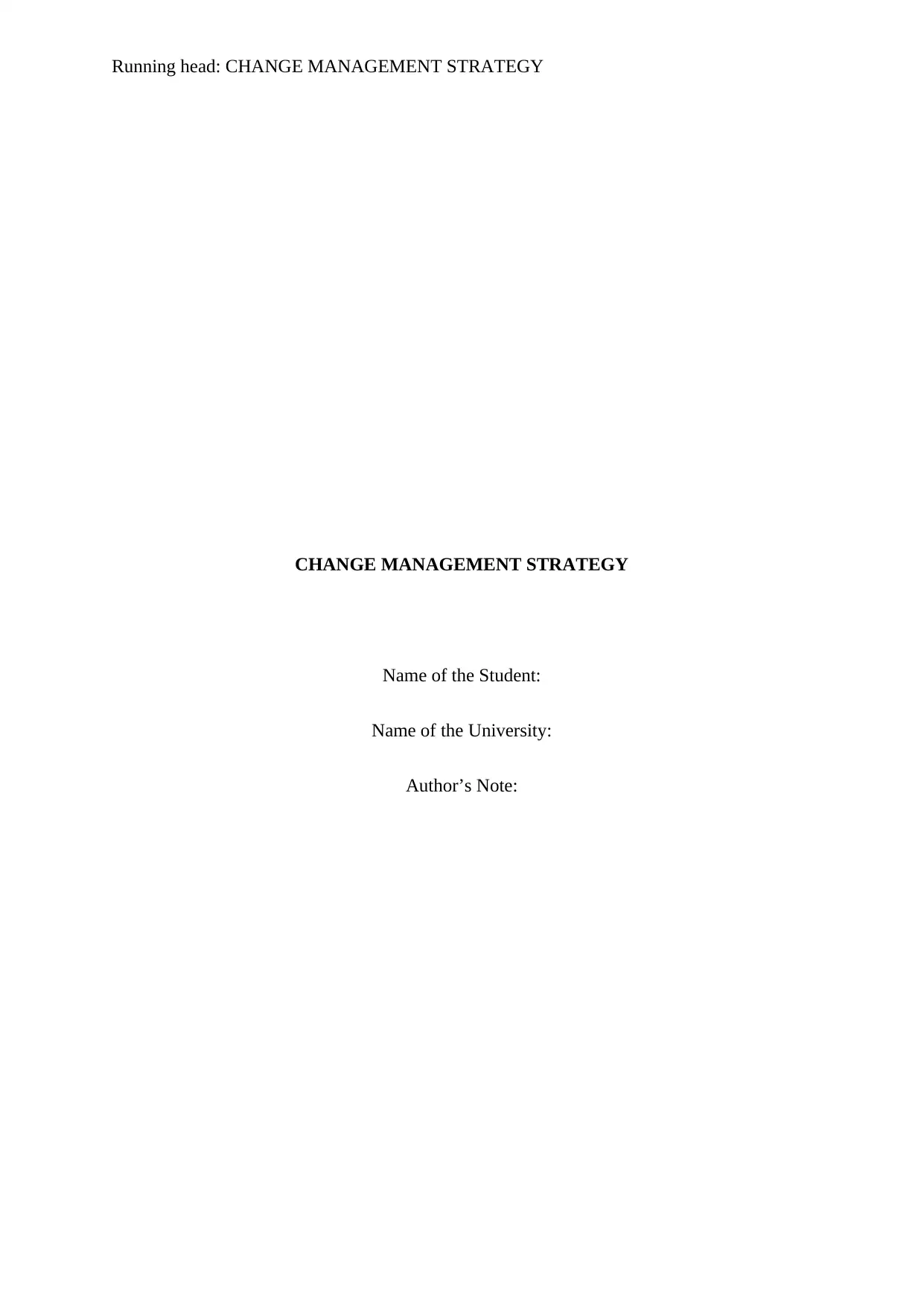
Running head: CHANGE MANAGEMENT STRATEGY
CHANGE MANAGEMENT STRATEGY
Name of the Student:
Name of the University:
Author’s Note:
CHANGE MANAGEMENT STRATEGY
Name of the Student:
Name of the University:
Author’s Note:
Paraphrase This Document
Need a fresh take? Get an instant paraphrase of this document with our AI Paraphraser
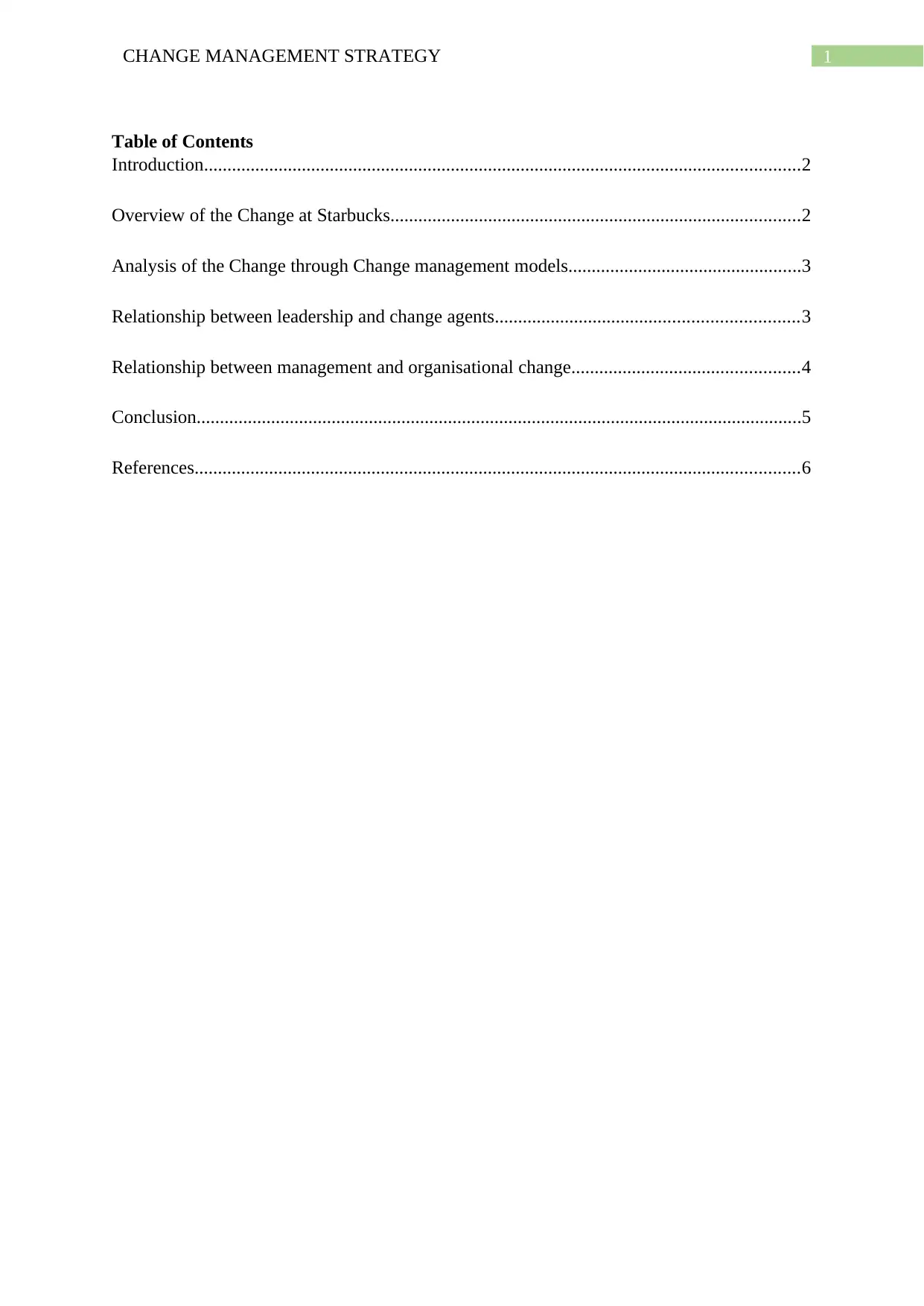
1CHANGE MANAGEMENT STRATEGY
Table of Contents
Introduction................................................................................................................................2
Overview of the Change at Starbucks........................................................................................2
Analysis of the Change through Change management models..................................................3
Relationship between leadership and change agents.................................................................3
Relationship between management and organisational change.................................................4
Conclusion..................................................................................................................................5
References..................................................................................................................................6
Table of Contents
Introduction................................................................................................................................2
Overview of the Change at Starbucks........................................................................................2
Analysis of the Change through Change management models..................................................3
Relationship between leadership and change agents.................................................................3
Relationship between management and organisational change.................................................4
Conclusion..................................................................................................................................5
References..................................................................................................................................6
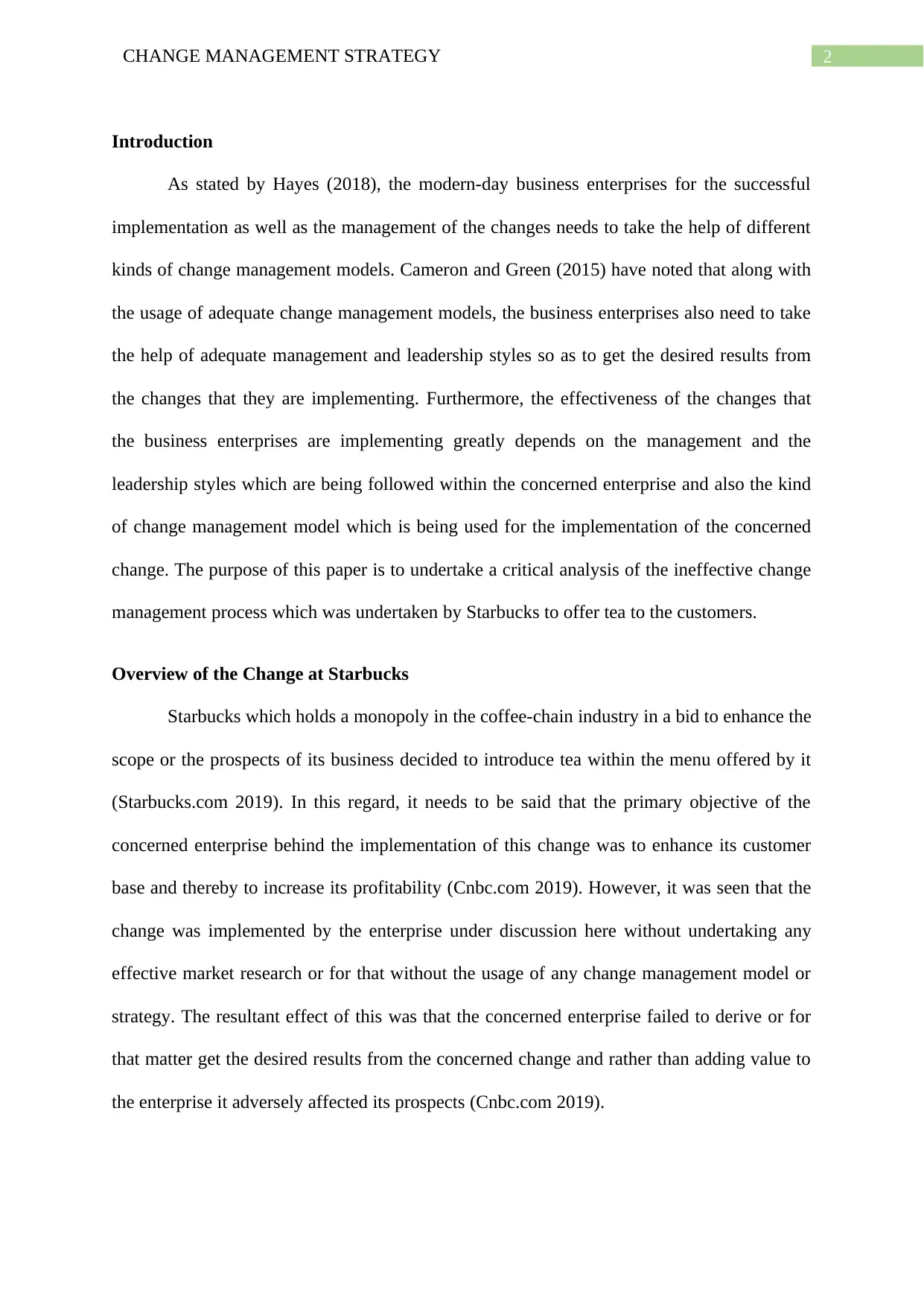
2CHANGE MANAGEMENT STRATEGY
Introduction
As stated by Hayes (2018), the modern-day business enterprises for the successful
implementation as well as the management of the changes needs to take the help of different
kinds of change management models. Cameron and Green (2015) have noted that along with
the usage of adequate change management models, the business enterprises also need to take
the help of adequate management and leadership styles so as to get the desired results from
the changes that they are implementing. Furthermore, the effectiveness of the changes that
the business enterprises are implementing greatly depends on the management and the
leadership styles which are being followed within the concerned enterprise and also the kind
of change management model which is being used for the implementation of the concerned
change. The purpose of this paper is to undertake a critical analysis of the ineffective change
management process which was undertaken by Starbucks to offer tea to the customers.
Overview of the Change at Starbucks
Starbucks which holds a monopoly in the coffee-chain industry in a bid to enhance the
scope or the prospects of its business decided to introduce tea within the menu offered by it
(Starbucks.com 2019). In this regard, it needs to be said that the primary objective of the
concerned enterprise behind the implementation of this change was to enhance its customer
base and thereby to increase its profitability (Cnbc.com 2019). However, it was seen that the
change was implemented by the enterprise under discussion here without undertaking any
effective market research or for that without the usage of any change management model or
strategy. The resultant effect of this was that the concerned enterprise failed to derive or for
that matter get the desired results from the concerned change and rather than adding value to
the enterprise it adversely affected its prospects (Cnbc.com 2019).
Introduction
As stated by Hayes (2018), the modern-day business enterprises for the successful
implementation as well as the management of the changes needs to take the help of different
kinds of change management models. Cameron and Green (2015) have noted that along with
the usage of adequate change management models, the business enterprises also need to take
the help of adequate management and leadership styles so as to get the desired results from
the changes that they are implementing. Furthermore, the effectiveness of the changes that
the business enterprises are implementing greatly depends on the management and the
leadership styles which are being followed within the concerned enterprise and also the kind
of change management model which is being used for the implementation of the concerned
change. The purpose of this paper is to undertake a critical analysis of the ineffective change
management process which was undertaken by Starbucks to offer tea to the customers.
Overview of the Change at Starbucks
Starbucks which holds a monopoly in the coffee-chain industry in a bid to enhance the
scope or the prospects of its business decided to introduce tea within the menu offered by it
(Starbucks.com 2019). In this regard, it needs to be said that the primary objective of the
concerned enterprise behind the implementation of this change was to enhance its customer
base and thereby to increase its profitability (Cnbc.com 2019). However, it was seen that the
change was implemented by the enterprise under discussion here without undertaking any
effective market research or for that without the usage of any change management model or
strategy. The resultant effect of this was that the concerned enterprise failed to derive or for
that matter get the desired results from the concerned change and rather than adding value to
the enterprise it adversely affected its prospects (Cnbc.com 2019).
⊘ This is a preview!⊘
Do you want full access?
Subscribe today to unlock all pages.

Trusted by 1+ million students worldwide
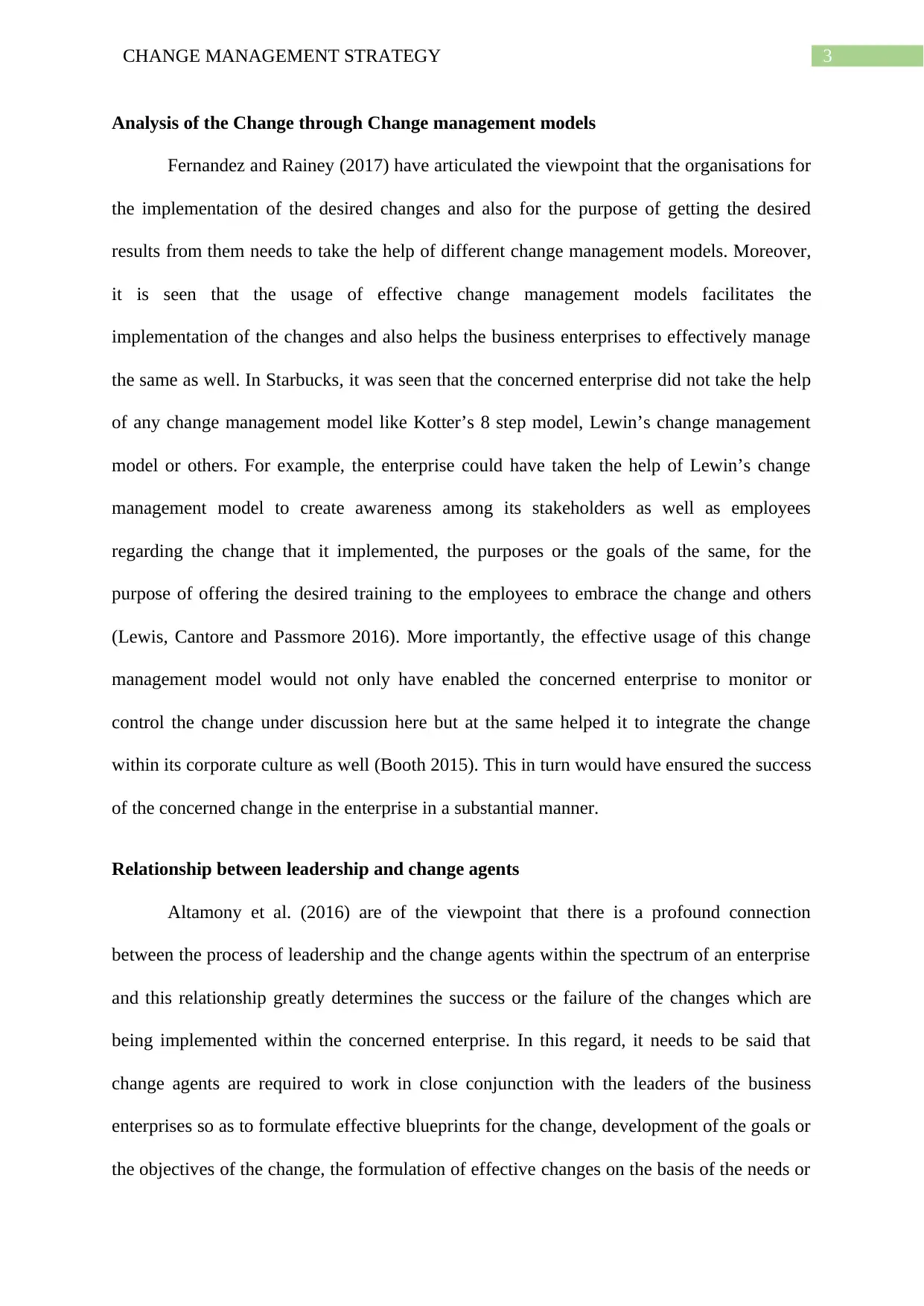
3CHANGE MANAGEMENT STRATEGY
Analysis of the Change through Change management models
Fernandez and Rainey (2017) have articulated the viewpoint that the organisations for
the implementation of the desired changes and also for the purpose of getting the desired
results from them needs to take the help of different change management models. Moreover,
it is seen that the usage of effective change management models facilitates the
implementation of the changes and also helps the business enterprises to effectively manage
the same as well. In Starbucks, it was seen that the concerned enterprise did not take the help
of any change management model like Kotter’s 8 step model, Lewin’s change management
model or others. For example, the enterprise could have taken the help of Lewin’s change
management model to create awareness among its stakeholders as well as employees
regarding the change that it implemented, the purposes or the goals of the same, for the
purpose of offering the desired training to the employees to embrace the change and others
(Lewis, Cantore and Passmore 2016). More importantly, the effective usage of this change
management model would not only have enabled the concerned enterprise to monitor or
control the change under discussion here but at the same helped it to integrate the change
within its corporate culture as well (Booth 2015). This in turn would have ensured the success
of the concerned change in the enterprise in a substantial manner.
Relationship between leadership and change agents
Altamony et al. (2016) are of the viewpoint that there is a profound connection
between the process of leadership and the change agents within the spectrum of an enterprise
and this relationship greatly determines the success or the failure of the changes which are
being implemented within the concerned enterprise. In this regard, it needs to be said that
change agents are required to work in close conjunction with the leaders of the business
enterprises so as to formulate effective blueprints for the change, development of the goals or
the objectives of the change, the formulation of effective changes on the basis of the needs or
Analysis of the Change through Change management models
Fernandez and Rainey (2017) have articulated the viewpoint that the organisations for
the implementation of the desired changes and also for the purpose of getting the desired
results from them needs to take the help of different change management models. Moreover,
it is seen that the usage of effective change management models facilitates the
implementation of the changes and also helps the business enterprises to effectively manage
the same as well. In Starbucks, it was seen that the concerned enterprise did not take the help
of any change management model like Kotter’s 8 step model, Lewin’s change management
model or others. For example, the enterprise could have taken the help of Lewin’s change
management model to create awareness among its stakeholders as well as employees
regarding the change that it implemented, the purposes or the goals of the same, for the
purpose of offering the desired training to the employees to embrace the change and others
(Lewis, Cantore and Passmore 2016). More importantly, the effective usage of this change
management model would not only have enabled the concerned enterprise to monitor or
control the change under discussion here but at the same helped it to integrate the change
within its corporate culture as well (Booth 2015). This in turn would have ensured the success
of the concerned change in the enterprise in a substantial manner.
Relationship between leadership and change agents
Altamony et al. (2016) are of the viewpoint that there is a profound connection
between the process of leadership and the change agents within the spectrum of an enterprise
and this relationship greatly determines the success or the failure of the changes which are
being implemented within the concerned enterprise. In this regard, it needs to be said that
change agents are required to work in close conjunction with the leaders of the business
enterprises so as to formulate effective blueprints for the change, development of the goals or
the objectives of the change, the formulation of effective changes on the basis of the needs or
Paraphrase This Document
Need a fresh take? Get an instant paraphrase of this document with our AI Paraphraser
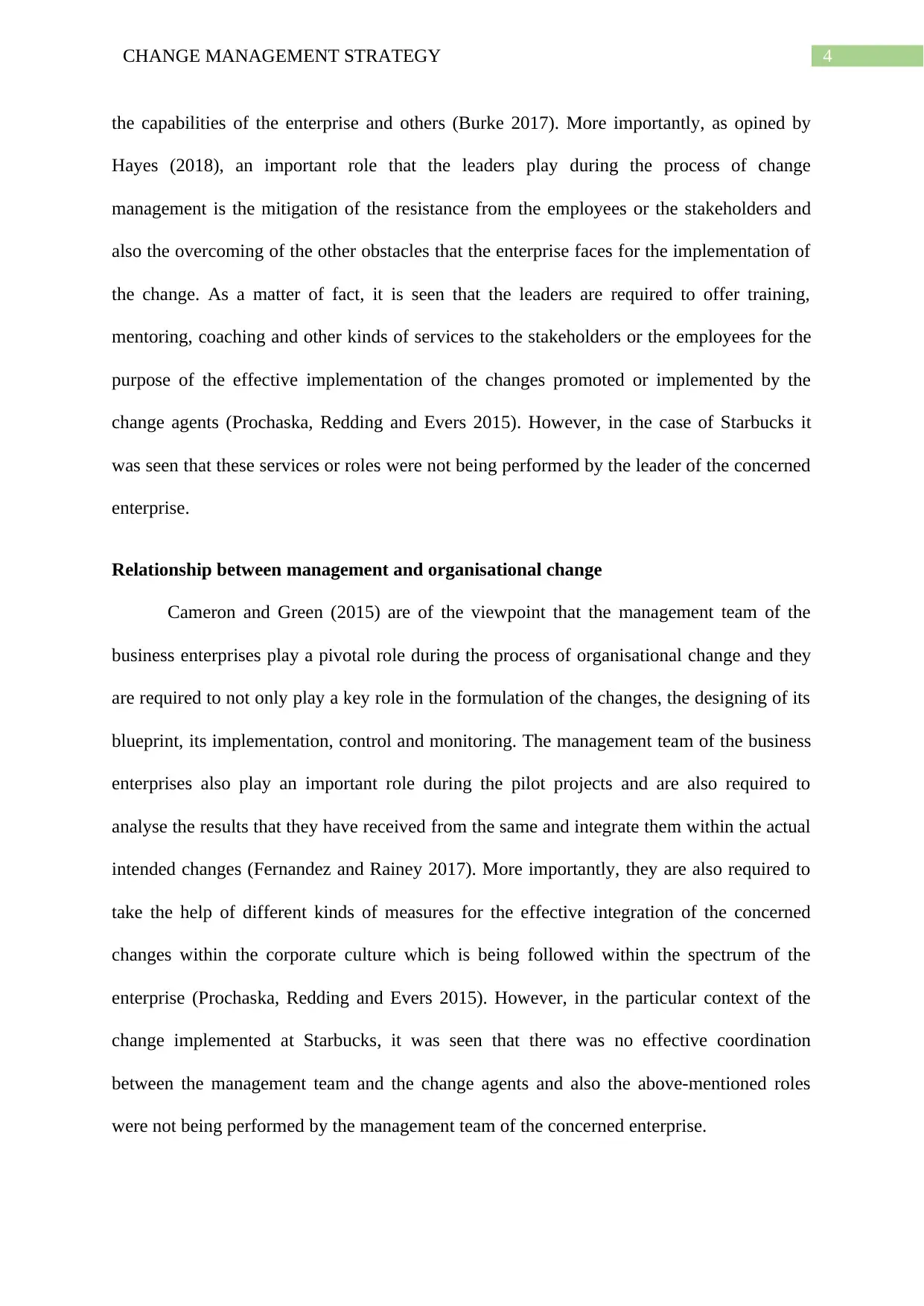
4CHANGE MANAGEMENT STRATEGY
the capabilities of the enterprise and others (Burke 2017). More importantly, as opined by
Hayes (2018), an important role that the leaders play during the process of change
management is the mitigation of the resistance from the employees or the stakeholders and
also the overcoming of the other obstacles that the enterprise faces for the implementation of
the change. As a matter of fact, it is seen that the leaders are required to offer training,
mentoring, coaching and other kinds of services to the stakeholders or the employees for the
purpose of the effective implementation of the changes promoted or implemented by the
change agents (Prochaska, Redding and Evers 2015). However, in the case of Starbucks it
was seen that these services or roles were not being performed by the leader of the concerned
enterprise.
Relationship between management and organisational change
Cameron and Green (2015) are of the viewpoint that the management team of the
business enterprises play a pivotal role during the process of organisational change and they
are required to not only play a key role in the formulation of the changes, the designing of its
blueprint, its implementation, control and monitoring. The management team of the business
enterprises also play an important role during the pilot projects and are also required to
analyse the results that they have received from the same and integrate them within the actual
intended changes (Fernandez and Rainey 2017). More importantly, they are also required to
take the help of different kinds of measures for the effective integration of the concerned
changes within the corporate culture which is being followed within the spectrum of the
enterprise (Prochaska, Redding and Evers 2015). However, in the particular context of the
change implemented at Starbucks, it was seen that there was no effective coordination
between the management team and the change agents and also the above-mentioned roles
were not being performed by the management team of the concerned enterprise.
the capabilities of the enterprise and others (Burke 2017). More importantly, as opined by
Hayes (2018), an important role that the leaders play during the process of change
management is the mitigation of the resistance from the employees or the stakeholders and
also the overcoming of the other obstacles that the enterprise faces for the implementation of
the change. As a matter of fact, it is seen that the leaders are required to offer training,
mentoring, coaching and other kinds of services to the stakeholders or the employees for the
purpose of the effective implementation of the changes promoted or implemented by the
change agents (Prochaska, Redding and Evers 2015). However, in the case of Starbucks it
was seen that these services or roles were not being performed by the leader of the concerned
enterprise.
Relationship between management and organisational change
Cameron and Green (2015) are of the viewpoint that the management team of the
business enterprises play a pivotal role during the process of organisational change and they
are required to not only play a key role in the formulation of the changes, the designing of its
blueprint, its implementation, control and monitoring. The management team of the business
enterprises also play an important role during the pilot projects and are also required to
analyse the results that they have received from the same and integrate them within the actual
intended changes (Fernandez and Rainey 2017). More importantly, they are also required to
take the help of different kinds of measures for the effective integration of the concerned
changes within the corporate culture which is being followed within the spectrum of the
enterprise (Prochaska, Redding and Evers 2015). However, in the particular context of the
change implemented at Starbucks, it was seen that there was no effective coordination
between the management team and the change agents and also the above-mentioned roles
were not being performed by the management team of the concerned enterprise.
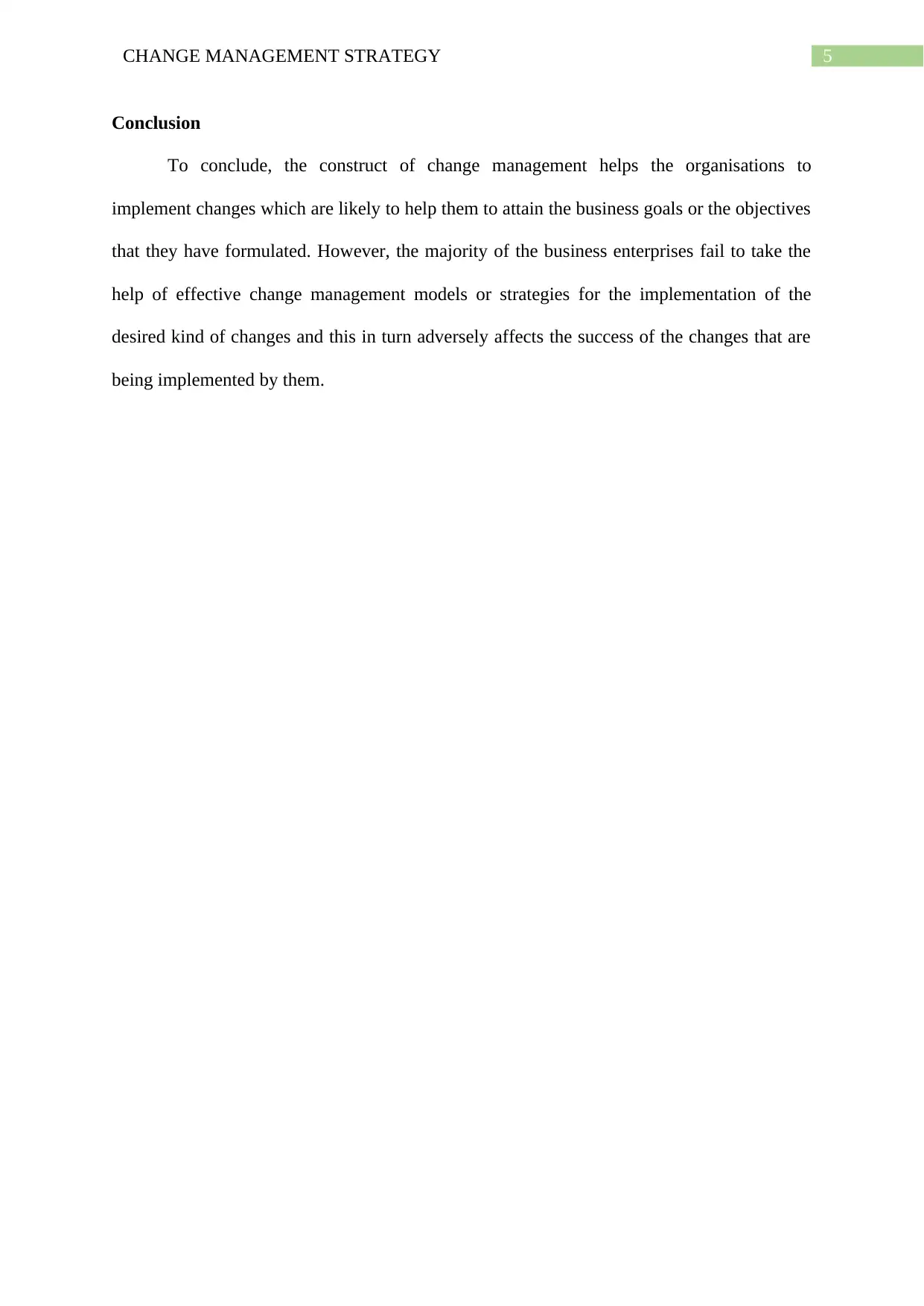
5CHANGE MANAGEMENT STRATEGY
Conclusion
To conclude, the construct of change management helps the organisations to
implement changes which are likely to help them to attain the business goals or the objectives
that they have formulated. However, the majority of the business enterprises fail to take the
help of effective change management models or strategies for the implementation of the
desired kind of changes and this in turn adversely affects the success of the changes that are
being implemented by them.
Conclusion
To conclude, the construct of change management helps the organisations to
implement changes which are likely to help them to attain the business goals or the objectives
that they have formulated. However, the majority of the business enterprises fail to take the
help of effective change management models or strategies for the implementation of the
desired kind of changes and this in turn adversely affects the success of the changes that are
being implemented by them.
⊘ This is a preview!⊘
Do you want full access?
Subscribe today to unlock all pages.

Trusted by 1+ million students worldwide
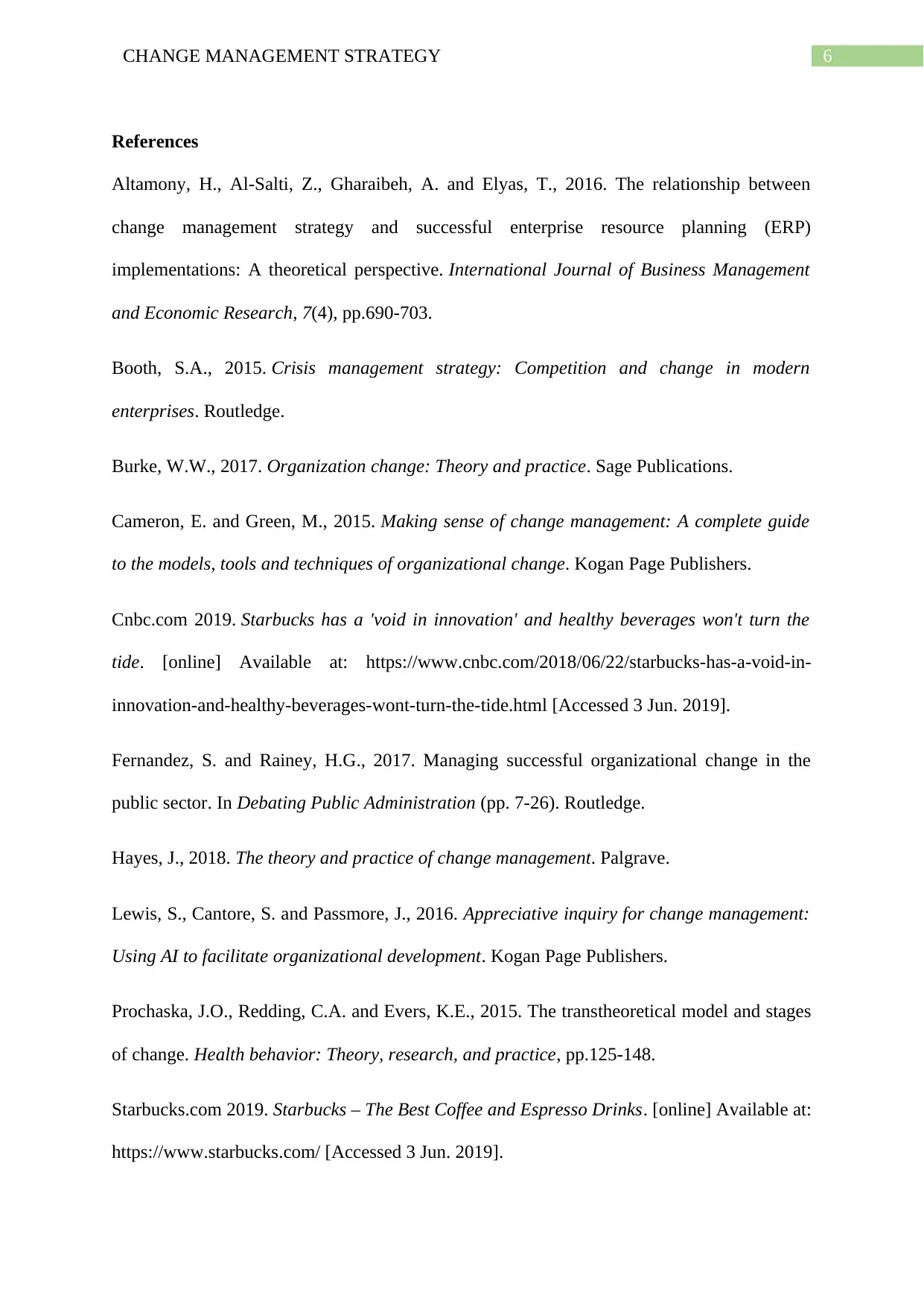
6CHANGE MANAGEMENT STRATEGY
References
Altamony, H., Al-Salti, Z., Gharaibeh, A. and Elyas, T., 2016. The relationship between
change management strategy and successful enterprise resource planning (ERP)
implementations: A theoretical perspective. International Journal of Business Management
and Economic Research, 7(4), pp.690-703.
Booth, S.A., 2015. Crisis management strategy: Competition and change in modern
enterprises. Routledge.
Burke, W.W., 2017. Organization change: Theory and practice. Sage Publications.
Cameron, E. and Green, M., 2015. Making sense of change management: A complete guide
to the models, tools and techniques of organizational change. Kogan Page Publishers.
Cnbc.com 2019. Starbucks has a 'void in innovation' and healthy beverages won't turn the
tide. [online] Available at: https://www.cnbc.com/2018/06/22/starbucks-has-a-void-in-
innovation-and-healthy-beverages-wont-turn-the-tide.html [Accessed 3 Jun. 2019].
Fernandez, S. and Rainey, H.G., 2017. Managing successful organizational change in the
public sector. In Debating Public Administration (pp. 7-26). Routledge.
Hayes, J., 2018. The theory and practice of change management. Palgrave.
Lewis, S., Cantore, S. and Passmore, J., 2016. Appreciative inquiry for change management:
Using AI to facilitate organizational development. Kogan Page Publishers.
Prochaska, J.O., Redding, C.A. and Evers, K.E., 2015. The transtheoretical model and stages
of change. Health behavior: Theory, research, and practice, pp.125-148.
Starbucks.com 2019. Starbucks – The Best Coffee and Espresso Drinks. [online] Available at:
https://www.starbucks.com/ [Accessed 3 Jun. 2019].
References
Altamony, H., Al-Salti, Z., Gharaibeh, A. and Elyas, T., 2016. The relationship between
change management strategy and successful enterprise resource planning (ERP)
implementations: A theoretical perspective. International Journal of Business Management
and Economic Research, 7(4), pp.690-703.
Booth, S.A., 2015. Crisis management strategy: Competition and change in modern
enterprises. Routledge.
Burke, W.W., 2017. Organization change: Theory and practice. Sage Publications.
Cameron, E. and Green, M., 2015. Making sense of change management: A complete guide
to the models, tools and techniques of organizational change. Kogan Page Publishers.
Cnbc.com 2019. Starbucks has a 'void in innovation' and healthy beverages won't turn the
tide. [online] Available at: https://www.cnbc.com/2018/06/22/starbucks-has-a-void-in-
innovation-and-healthy-beverages-wont-turn-the-tide.html [Accessed 3 Jun. 2019].
Fernandez, S. and Rainey, H.G., 2017. Managing successful organizational change in the
public sector. In Debating Public Administration (pp. 7-26). Routledge.
Hayes, J., 2018. The theory and practice of change management. Palgrave.
Lewis, S., Cantore, S. and Passmore, J., 2016. Appreciative inquiry for change management:
Using AI to facilitate organizational development. Kogan Page Publishers.
Prochaska, J.O., Redding, C.A. and Evers, K.E., 2015. The transtheoretical model and stages
of change. Health behavior: Theory, research, and practice, pp.125-148.
Starbucks.com 2019. Starbucks – The Best Coffee and Espresso Drinks. [online] Available at:
https://www.starbucks.com/ [Accessed 3 Jun. 2019].
Paraphrase This Document
Need a fresh take? Get an instant paraphrase of this document with our AI Paraphraser
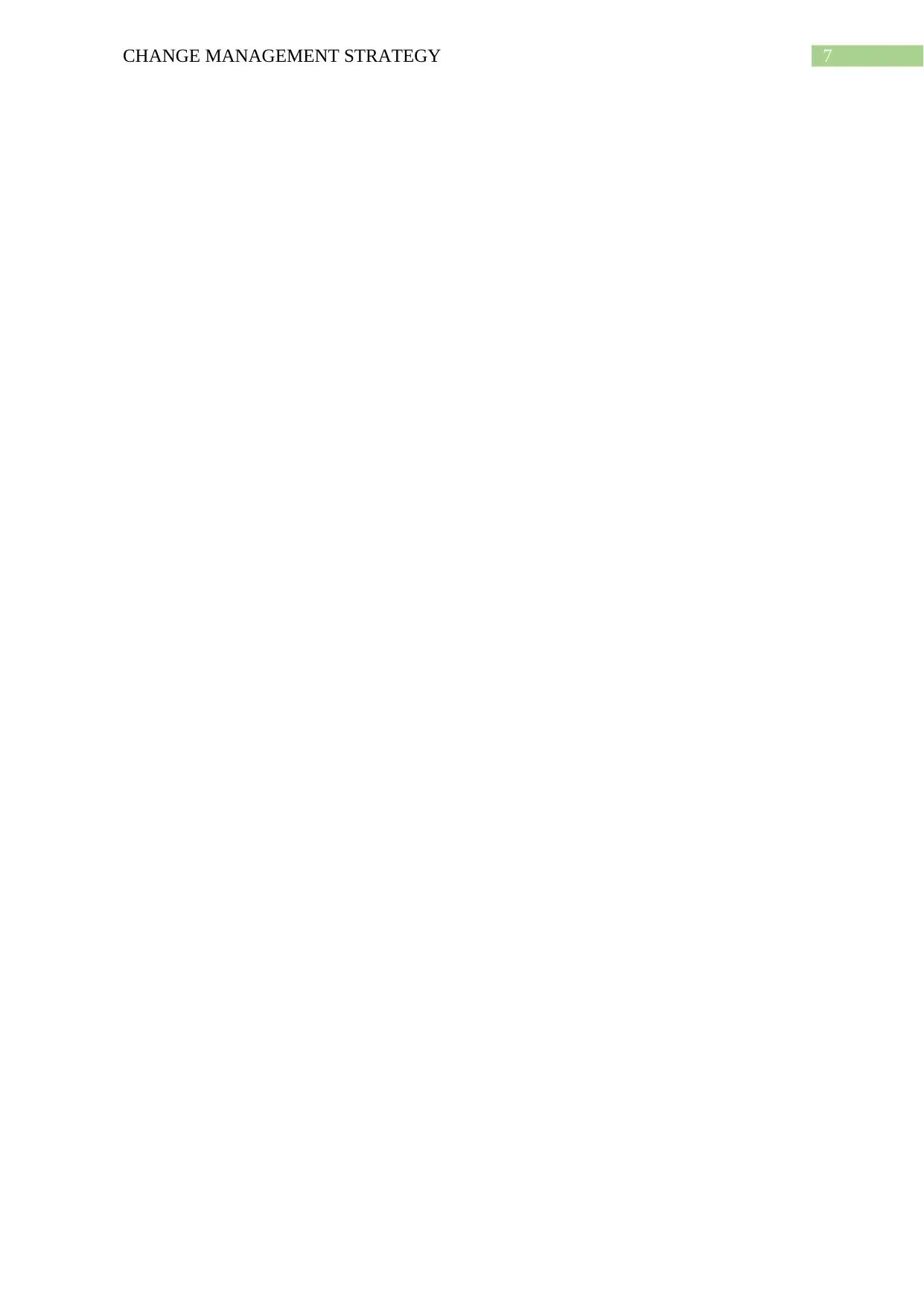
7CHANGE MANAGEMENT STRATEGY
1 out of 8
Related Documents
Your All-in-One AI-Powered Toolkit for Academic Success.
+13062052269
info@desklib.com
Available 24*7 on WhatsApp / Email
![[object Object]](/_next/static/media/star-bottom.7253800d.svg)
Unlock your academic potential
Copyright © 2020–2025 A2Z Services. All Rights Reserved. Developed and managed by ZUCOL.





